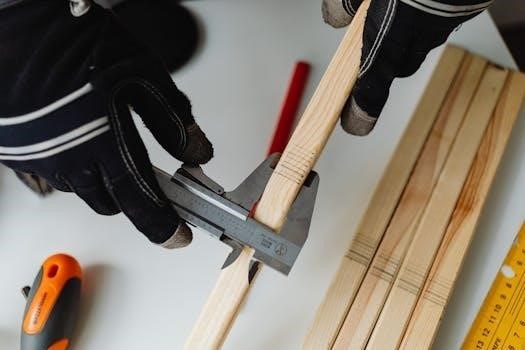Wood framing is a time-honored construction method‚ forming the structural basis for many buildings. This technique involves assembling wooden members like beams and studs to create a robust framework. It’s adaptable and economical for various architectural styles.
Overview of Wood Framing
Wood framing‚ also referred to as stick framing or timber framing‚ is a prevalent construction method utilizing lumber assembled to create a building’s skeletal structure. This method relies on a network of wooden studs‚ beams‚ and joists‚ typically nailed or fastened together‚ and mounted to the foundation. The framework provides the structural support necessary for the rest of the building. It is very adaptable‚ suitable for both residential and commercial buildings. The process involves careful planning and precise execution‚ ensuring the load-bearing capacity and overall stability of the structure. Wood framing allows for design flexibility and is widely used for its affordability and ease of use in various construction projects. It forms the fundamental framework of walls‚ floors‚ and roofs‚ providing a secure and durable base for interior and exterior finishes. This method is a cornerstone of modern construction techniques.
Advantages of Wood Framing
Wood framing offers numerous benefits in construction‚ making it a preferred choice for many projects. One key advantage is its cost-effectiveness; lumber is generally more affordable than steel or concrete‚ leading to lower overall building costs. Additionally‚ wood is a renewable resource‚ making it a sustainable building material. Wood frame construction is also known for its ease of use and flexibility. It’s relatively straightforward to work with‚ allowing for quick construction times and design modifications. The lightweight nature of wood makes it easier to transport and handle on site‚ reducing labor costs and time. Moreover‚ wood provides excellent insulation‚ contributing to energy-efficient buildings. Wood frame structures also offer a high level of design flexibility‚ allowing for a wide range of architectural styles and customizations. Its ability to be easily joined and shaped makes it a versatile and practical choice for many building projects.

Key Components of Wood Framing
Wood framing relies on various components like lumber‚ studs‚ joists‚ and sheathing. These elements work together to provide structural integrity to floors‚ walls‚ and roofs. Proper selection and assembly are essential.
Common Lumber Sizes and Materials
In wood frame construction‚ understanding lumber sizes and materials is crucial. Common lumber dimensions‚ such as 2x4s and 2x6s‚ are frequently used for wall studs‚ while 2x8s‚ 2x10s‚ or larger may be employed for joists and rafters. These dimensions are nominal‚ meaning the actual size is slightly smaller than the stated size. For example‚ a 2×4 actually measures 1.5 inches by 3.5 inches. Lumber is graded for strength and appearance‚ with grades like “Select‚” “No. 1‚” and “No. 2” indicating quality. Different types of wood are used‚ with softwoods like pine‚ fir‚ and spruce being popular choices due to their availability and workability. Pressure-treated lumber is often used for components in contact with the ground or exposed to moisture. Engineered wood products‚ such as I-joists and laminated veneer lumber‚ offer enhanced strength and dimensional stability. Correct material selection ensures a safe and durable structure.
Floor Framing Elements
Floor framing is a critical aspect of wood frame construction‚ providing the foundation for the structure’s floors. Key elements include floor joists‚ which are horizontal members that support the floor sheathing and loads. These are typically made from lumber or engineered wood. Sill plates are attached to the foundation wall to provide a base for the joists. Girders or beams‚ often made from laminated wood or steel‚ provide support to the joists spanning longer distances. Bridging or blocking is placed between joists to prevent twisting and distribute loads. Subflooring‚ typically made of plywood or oriented strand board (OSB)‚ is laid over the joists to create a stable surface. Proper spacing and secure connections are essential for a strong and stable floor system. Applying wood glue to the subfloor before attaching it to the joists can prevent squeaking. Understanding these components is important for successful floor construction.
Wall Framing Elements
Wall framing in wood construction involves vertical studs‚ which are the main structural members‚ typically 2x4s or 2x6s. These are spaced according to code and design requirements to support the wall sheathing and loads. Top and sole plates are horizontal members that run along the top and bottom of the studs‚ connecting them and providing a nailing surface. Headers are used above door and window openings to carry the load over the opening. Cripple studs are short studs used above or below openings or between headers and top plates. Sheathing‚ typically plywood or OSB‚ is applied to the exterior of the wall framing to provide structural support and a base for siding. Proper sizing‚ spacing‚ and secure connections of these elements are vital for a strong and durable wall structure. Corners and intersections require special attention to ensure structural integrity. Windows and doors are fastened to the wood framing per manufacturers specifications.

Roof Framing Elements
Roof framing primarily consists of rafters or trusses‚ which form the structural support for the roof. Rafters are individual sloped beams that extend from the ridge to the wall plate‚ while trusses are pre-fabricated assemblies designed to span a given distance. Ridge boards are horizontal members at the peak of the roof‚ providing a connection point for rafters. Ceiling joists run horizontally‚ connecting exterior walls and providing support for the ceiling. Collar ties are horizontal members that connect opposite rafters‚ preventing roof sagging or outward pressure. Sheathing‚ usually plywood or OSB‚ is attached to the rafters or trusses to provide a solid base for roofing materials. Proper roof framing ensures structural stability‚ load distribution‚ and protection from the elements. The selection of rafters or trusses depends on design and structural requirements. Ventilation is also a key consideration in roof framing design.

Wood Framing Construction Methods
Wood framing employs two main methods⁚ light-frame and heavy-frame. Light-frame utilizes smaller‚ numerous supports‚ while heavy-frame uses fewer‚ larger ones. Understanding these methods is crucial for construction planning and execution.
Light-Frame vs Heavy-Frame Construction
Light-frame construction‚ often referred to as stick framing‚ is the predominant method for residential buildings. It utilizes numerous‚ smaller dimension lumber pieces‚ such as 2x4s and 2x6s‚ spaced closely together to create a structural grid. This approach offers flexibility and ease of modification on-site‚ making it a popular choice for custom homes and renovations. The smaller lumber is easier to handle‚ contributing to faster construction times. Heavy-frame construction‚ on the other hand‚ employs larger‚ heavier timbers‚ often connected with intricate joinery‚ and is more common in commercial and historical buildings. This method requires specialized skills and equipment‚ resulting in a more robust and durable structure. The choice between light and heavy-frame depends on various factors including building size‚ design requirements‚ budget‚ and the intended use of the structure. Both approaches offer unique advantages‚ making them suitable for different types of construction projects. Understanding the differences between them is essential for making informed decisions.
Step-by-Step Framing Process
The framing process begins with establishing a solid foundation‚ ensuring it’s level and accurately measured. Next‚ the sill plates are attached to the foundation‚ providing a base for the floor system. Floor joists are then installed‚ creating the structural framework for the subfloor. Sheathing is applied over the joists‚ forming a solid surface. After the floor is complete‚ wall framing commences. Studs are assembled‚ creating wall sections‚ and headers are added over window and door openings. These wall sections are then raised and secured to the floor system and to each other. The roof framing is then constructed‚ typically involving rafters or trusses which are installed to provide structural support and shape. Finally‚ sheathing is installed on the walls and roof‚ preparing the structure for siding and roofing materials. Throughout the process‚ proper alignment‚ fastening‚ and attention to detail are crucial to ensure a structurally sound and stable framework. This step-by-step method helps ensure the project stays on track.

Safety and Standards
Safety in wood framing is paramount‚ requiring protective gear and adherence to building codes. These codes ensure structural integrity and occupant safety. Following safety guidelines minimizes accidents and injuries on site.
Safety Measures in Wood Framing
Prioritizing safety on a wood framing construction site is crucial‚ involving several key practices to mitigate potential hazards. The use of Personal Protective Equipment (PPE) is fundamental‚ including hard hats‚ safety glasses‚ and work gloves‚ ensuring that workers are protected from common construction-related injuries. Proper handling and storage of lumber are essential to prevent accidents from falling materials or improper stacking. Utilizing safe lifting techniques and equipment can help to avoid back injuries and other strains. Implementing fall protection measures‚ such as guardrails and harnesses‚ is vital‚ especially when working at heights. Maintaining a clean and organized worksite reduces the risk of slips‚ trips‚ and falls. Regular toolbox talks and safety meetings help reinforce safe practices and address specific concerns. Additionally‚ ensuring that all power tools are in good working condition and are used correctly is paramount for preventing accidents. Adhering to these safety protocols significantly contributes to a secure and productive construction environment.
Building Codes and Standards
Adherence to building codes and standards is paramount in wood frame construction‚ ensuring structural integrity and safety. The 2018 Wood Frame Construction Manual (WFCM)‚ an ANSI-approved American National Standard‚ is a crucial resource‚ referenced in the International Building Code (IBC) and the International Residential Code (IRC). These codes outline prescriptive guidelines for connections‚ wall systems‚ floor systems‚ and roof systems‚ covering a wide range of structural elements like sawn lumber‚ glued laminated timber‚ and I-joists. They also specify requirements for lumber dimensions‚ spacing‚ and fastening methods. These standards also address high-wind conditions and other geographical factors‚ ensuring buildings can withstand local environmental forces. Following these established codes and standards is mandatory for all construction‚ and these documents provide critical reference for builders‚ inspectors‚ and designers to ensure building quality and safety. Compliance with these standards is not only a legal requirement but also a commitment to constructing durable and reliable structures.

Leave a Reply
You must be logged in to post a comment.